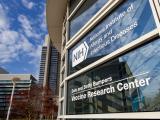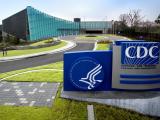Nov 3, 2005 (CIDRAP News) – In the event of an influenza pandemic, medical and public health personnel and workers who make critical vaccines and drugs would have first call on scarce doses of vaccine, under the pandemic plan released by the federal government yesterday.
People at high risk for dying of flu rank second among the vaccination priority groups recommended in the Department of Health and Human Services (HHS) Pandemic Influenza Plan. They are followed by pregnant women, household contacts of certain vulnerable people, public health emergency response workers, and key government leaders.
The plan also lists priority groups for treatment with the limited supplies of antiviral drugs that would be available if a pandemic erupted any time soon. First on that list are hospitalized flu patients, followed by healthcare workers who provide direct patient care, including emergency medical service (EMS) providers, and then highest-risk outpatients. Next come pandemic response workers, public safety personnel, certain other outpatients, and nursing home residents.
Two committees, the Advisory Committee on Immunization Practices (ACIP) and the National Vaccine Advisory Committee (NVAC), produced the vaccination recommendations. The NVAC alone produced the recommendations on antiviral treatment.
HHS has a stated goal of stockpiling 20 million doses of a vaccine for the H5N1 avian flu virus, the focus of concern about a flu pandemic. Two companies are under contract to make a vaccine for the virus, but how many doses those contracts will yield is unknown because the optimal dose of vaccine has not been determined. The government also hopes to acquire enough doses of antiviral drugs to treat 25% of the population.
In making the vaccination recommendations, the two advisory committees assumed that in any given local outbreak during a pandemic, between 25% and 30% of the population will get sick and that 10% of workers will stay home at the peak of the outbreak.
Vaccination priorities
The vaccine recommendations divide the population into four tiers, with several sets of groups in the top two tiers. The first tier includes the following groups:
- Priority A: People working in or supporting production of flu vaccines and antiviral drugs (estimated at 40,000), medical and public health workers in direct contact with patients, and vaccinators (estimated at 8 million to 9 million)
- Priority B (high-risk groups): People older than 64 with one or more high-risk conditions (about 18.2 million), people aged 6 months to 64 years with two or more high-risk conditions (about 6.9 million), and those older than 6 months who were hospitalized for flu or pneumonia within the past year (about 740,000)
- Priority C: Pregnant women (about 3 million), household contacts of severely immunocompromised people who would not be vaccinated because of likely poor response to vaccine (about 2.7 million), and household contacts of babies younger than 6 months (about 5 million)
- Priority D: Public health emergency response workers (150,000), and key government leaders managing pandemic response
Priority groups in the second tier are as follows:
- Priority A: Healthy people older than 64, people aged 6 months to 64 years with one high-risk condition (35.8 million), and healthy children aged 6 to 23 months (5.6 million)
- Priority B: Other public health emergency responders (300,000); public safety workers and prison staff (2.99 million); essential utility workers (364,000); transportation workers hauling fuel, water, food, and medical supplies, and running public transportation (3.8 million); and essential telecommunications and information technology workers
The third tier includes other key health decision makers in government, plus funeral workers. In the fourth tier is the rest of the population, an estimated 179.3 million.
The committees made recommendations only for civilians, though they recognized that military personnel would be a high priority as well, the plan says. The Department of Defense said 1.5 million service members would need vaccination to maintain current combat operations and the military medical system.
Not listed among the high-priority groups were patients in skilled nursing homes, who are normally a priority group for vaccination against seasonal flu. Because of a poor immune response to vaccination, they are less likely to benefit from vaccine than other groups that are also at high risk, the plan says. Some studies have suggested that vaccination of health care workers may be a better strategy for protecting nursing home residents, the document says.
The plan makes similar points about severely immunocompromised patients, saying vaccination of healthcare workers and household contacts is a better way to protect them.
Plan wins qualified praise
The pandemic plan won qualified praise from various disease and public health experts and groups.
Harry Hull, MD, Minnesota state epidemiologist, yesterday called the plan very comprehensive, but cautioned that the nature of such efforts requires constant work to improve preparedness.
"The general outline is great," Hull told CIDRAP News, lauding the emphasis on assisting Asia and stockpiling antivirals.
States need to improve infrastructure, including in surveillance, information technology, and isolation and quarantine, and those efforts will cost money, Hull added. In asking Congress for $7.1 billion for pandemic preparedness this week, President Bush called for $100 million for state efforts.
"As long as the funding is there it will help us shore up the infrastructure," he said, but added that those needs are long-term. "How long will [the money] last? Can it be turned into permanent funding?"
Hull also noted that practice, not paper, ensures preparedness. "Preparedness is more than running a plan. It's getting people to work together and act together . . . it's an ongoing process," he said.
Michael T. Osterholm, PhD, MPH, a leading advocate of pandemic preparedness, called the plan a big improvement over the draft released last year. He particularly praised it for recognizing the possibility of a pandemic like the disastrous one of 1918.
"This draft realizes if we were to experience a 1918-like scenario again, the number of cases and deaths as well as societal impact will be catastrophic," he told CIDRAP News. "And for that reason we really have no choice but to plan for such a scenario and hope that any future pandemic will have less impact."
Osterholm, director of CIDRAP, publisher of this Web site, also lauded the plan for recognizing "that we need an aggressive and forward-leaning program for vaccines and antivirals," even though vaccines and drugs would play a very limited role if a pandemic emerged within the next year.
He gave HHS "great credit" for making recommendations about rationing of vaccines and antivirals. "I'm not sure it's exactly what I believe should be the priorities, but I think it's a very important first step in having that discussion at the state and local level. And it sets a national framework for that."
However, Osterholm cautioned that plans for the use of antiviral drugs may have limited usefulness because no one knows whether the size of dose used against ordinary flu would work against a pandemic strain. "If the doses are going to be different than for H3N2 [seasonal flu], then all this talk about the number of doses is irrelevant," he said.
In addition, he said the plan should offer more detailed guidance for states and local health agencies in some areas. "One of the things we need to do right now is work much more in the area of standards of care, how we are going to do out-of-hospital care. Issues like that are critical and need to be fleshed out much more than they are now."
The National Association of County and City Health Officials (NACCHO) lauded the plan for its comprehensiveness, but voiced "great concern" about inadequate funding for preparation and response.
"The Administration's plan enumerates broad responsibilities for local and state governments in responding to an influenza pandemic. However, earlier this year, the Administration proposed a cut of $130 million in state and local public health preparedness. Although the Administration yesterday proposed an additional $100 million in funding for both state and local pandemic influenza preparedness, this sum does not even offset the previous proposed cut in funding," NACCHO said in a news release yesterday.
Jeffrey Levi, PhD, senior policy adviser for Trust for America's Health (TFAH), a nonprofit organization whose mission is to protect community health and make disease prevention a national priority, reacted in a news release published Nov 1.
Levi praised the administration's strategy budget request as evidence that pandemic flu is being taken seriously. However, he cited "significant gaps" that need to be addressed. The $100 million budget request doesn't adequately fund state and local health departments, surge capacity, or risk communication, he asserted.
Further, he said the plan lacks substance and detail, particularly in the areas of business operations, transportation and civic life. (In a teleconference on Wednesday, HHS Secretary Mike Leavitt said this plan isn't meant to cover anything beyond the public health and medical response aspects of a pandemic. He promised that other plans will be forthcoming from other areas of government.)
Levi also said it is disturbing that the HHS plan calls for the Department of Homeland Security to lead the response, "essentially divorcing the expertise that will be needed to respond to a complicated health threat from the top chain of leadership."
Staff writer Amy L. Becker contributed to this report.
See also:
TFAH news release
http://healthyamericans.org/newsroom/releases/release110105.pdf





















